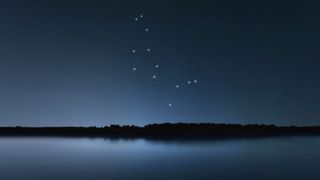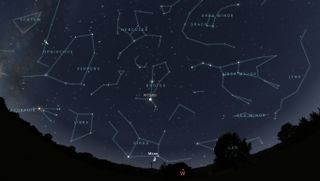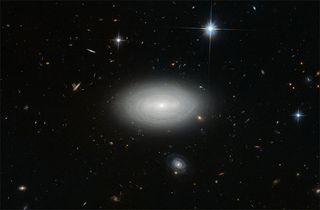Boötes constellation: Location, stars and mythology
This springtime Boötes can be seen chasing the Big Dipper around the northern sky.

Boötes is the 13th largest constellation in the night sky and contains one of the brightest stars in the sky, Arcturus.
Boötes is an ancient Greek word that roughly translates as the ox-driver, or herdsman. The herdsman can be seen driving his great plow, the Big Dipper, in a great circle around the north star, Polaris. The two dots over the second "o" indicate that both "o's" should be pronounced separately as "boh-OH-teez. It is one of 48 constellations cataloged by the astronomer Ptolemy in the second century.
Though Boötes is a large constellation, it contains few astronomical objects. In fact, the constellation is the home to the Boötes Void, an area of the universe 250 to 330 million light-years across that is nearly empty, containing only a handful of galaxies, according to NASA.
Related: Night sky: What you can see tonight (maps)
Where is Boötes and when can you see it?
Boötes covers an area of 907 square degrees and is visible in the northern hemisphere between latitudes of 90 and -50 degrees, according to Constellation Guide. It has a right ascension of 15 hours and a declination of 30 degrees, according to The Sky.
Boötes is best seen in the springtime, rising in the northeast after sunset, but remains visible through the summer. A simple way of finding the constellation is to look along the handle of the Big Dipper away from its spout, arcing to the bright orange star Arcturus, forming the base of the constellation Boötes, which may look like a kite to some.
Circling Polaris, the herdsman can be seen along with his two trusted hunting dogs, which are represented by the constellation Canes Venatici on his right flank. Boötes also stands proudly next to three constellations: Hercules and Corona Borealis are on his left, while Virgo lies below.

Boötes observing targets
Boötes faces away from the celestial sphere of the Milky Way, meaning that it doesn't have open clusters or nebulas that are visible to us. But though this constellation doesn't have as many astronomical objects as some, it still has some interesting targets for stargazing. Virtually all require a telescope or a pair of binoculars to view, and some very dim objects in Boötes can only be viewed with a large telescope. If you need equipment, our best binoculars and best telescopes guides may help.
Jargon buster
Magnitude: An object's magnitude is a measure of how bright an object appears from Earth. Brightness is measured on a numbered scale, with lower numbers being brighter than higher numbers. And it even goes negative!
Right ascension (RA): Right ascension is the sky's equivalent to longitude on Earth, and it helps astronomers locate celestial objects. It covers the east-west direction and is measured in hours, minutes and seconds.
Declination (Dec): Declination also helps astronomers locate celestial objects in the sky — it is akin to latitude on Earth. It marks how high an object will rise in the sky, covering the north-south direction in units of degrees, arcminutes and arcseconds (60 arcseconds in an arcmin, 60 arcmins in a degree).
NGC 5466
Magnitude: 10.5
Approximate distance from Earth: 51, 800 light-years
Location: 14h 05m 27.29s (right ascension), +28° 32' 04.0" (declination).
With a diameter of about 11 arcseconds, this large, relatively sparse globular cluster has a low surface brightness, so you may be best off observing it with a small telescope, though it's also visible through binoculars with an 80-millimeter aperture, according to The Sky Live. The cluster contains many blue horizontal branch stars. These are stars around the mass of the sun which, having exhausted the hydrogen in their core, fuse helium instead, while hydrogen fusion happens in a surrounding shell.
NGC 5248
Magnitude: 10.03
Approximate distance from Earth: 59 million light-years
Coordinates: 13h 37m 32.024s (right ascension) +08° 53' 06.64" (declination)
One of two bright galaxies in Boötes, this intermediate spiral galaxy has a structure in between a "barred" and "unbarred" spiral galaxy. Barred galaxies, such as our own Milky Way, have a straight, bar-light structure of stars at their center. Scientists think the bars, which may be stellar nurseries, are temporary and gradually disappear as galaxies get older and larger. You can view this galaxy using a telescope with a 6-inch (150-millimeter) aperture.
NGC 5676
Magnitude: 9.78
Approximate distance from Earth: 100 million light years
Location: 14h 32m 46.8s (right ascension), +49° 27' 28" (declination)
This second bright spiral galaxy has a striking, asymmetrical appearance. While the spiral arms on its north side are shorter and well-defined, those on its south side are chaotic and extend twice as far from the center of the galaxy. Galaxies with fragmented spiral arms like this one are called flocculent galaxies. You can view this galaxy using a telescope with an aperture of at least 8 inches (200 millimeters).
NGC 5698
Magnitude: 12.62
Approximate distance from Earth: 129 million light years
Coordinates: 14h 37m 14.696 s, (right ascension), +38° 27' 15.36" (declination)
This galaxy hosted a 2005 supernova, the violent explosion of a colossal star. The supernova, classified as Type Ia, was caused by a white dwarf, an incredibly dense remnant of a star, gaining mass from another star in a binary system. The extra mass ignited a runaway fusion process, creating more energy than the gravity holding the star together and producing a massive explosion. This galaxy requires a large telescope to observe, with an aperture of 14 inches (350 millimeters).
Boötes Void

Magnitude: N/A
Approximate distance from Earth: 700 million light years
Coordinates: 14h 50m (right ascension), 46d (declination)
More of a lack of features than a feature itself, the Boötes Void is one of the most well-known aspects of this constellation. It contains around 60 galaxies; other areas of the sky around the same size contain about 2,000. Scientists think that this void, one of the largest known, formed when several smaller voids merged. Look towards the Boötes Void and you'll be seeing one of the emptiest places in the known universe.
Related: Is this the loneliest galaxy in the universe?
Quadrantids meteor shower

Boötes hosts the Quadrantids, a meteor shower named after Quadrans Muralis, a previous constellation including parts of Bootes and the constellation Draco. Its source is thought to be material previously shed from the asteroid 2003 EH1. The shower happens between December 28 and January 12 each year, producing as many as 200 meteors per hour at its peak under perfect conditions, according to NASA. Though this is about as many as other well-known meteor showers, such as the Perseids, the shower's peak only lasts hours rather than days, making it more difficult to observe. The constellation is also home to more minor meteor showers, such as the Alpha Bootids, the June Bootids, the Beta Bootids, and several others.
Related: When is the next meteor shower?
Mythology
Though the name Boötes comes from ancient Greek, it's not entirely clear who in Greek mythology this herdsman is supposed to represent. According to Constellation Guide, it could represent Arcas, son of Zeus and Callisto. Hera, Zeus' wife, transformed Callisto into a bear when she heard of Zeus's disloyalty, but one day Arcas, who didn't recognize his mother, attempted to hunt her. Zeus placed them in the sky — Arcas as Boötes and Callisto as Ursa Major — to prevent Arcas from mistakenly killing her.
In another story, Boötes is a grape farmer and winemaker named Icarius. Placed in the sky in memorial by Dionysus, the god had been impressed by Icarius' vineyards and taught him to make wine. Unfortunately, Icarius' friends murdered him after a night of drinking because they assumed from the wine's effects that he was trying to poison them. In yet another myth, Boötes is the inventor of the first plough, placed in the sky by Ceres, the goddess of agriculture.
Boötes constellation FAQs answered by an expert
We asked Dr. Jake D. Turner a few frequently asked questions about the Boötes constellation.

Dr. Jake D. Turner is a NASA Sagan Postdoctoral Fellow at Cornell University and the Carl Sagan Institute. Turner's research is focused on studying the magnetic fields, atmospheres, and orbital evolution of exoplanets.
Where is the Boötes Constellation?
The Boötes is a constellation mainly seen in the northern hemisphere. It is visible from early spring until autumn.
How can you the Boötes constellation?
To find Bootes:
1.) Look for the Big Dipper
2.) Follow the curve of the Big Dipper's handle to a bright orange star, Arcturus.
3.) You will notice that the brightest stars of Boötes form a cone shape, where Arcturus is at the base of the cone.
How many stars are in the Boötes constellation?
There are 15 main stars in Boötes.
Are their exoplanets in the Boötes constellation?
Yes, there are at least 10 exoplanets known in the Bootes constellation. The most famous planet in Bootes is Tau Bootes b. The planet was discovered in 1997 and was one of the first exoplanets found. Regarding my own research, Tau Bootes b is the first possible exoplanet that we have detected in the radio realm.
Additional resources
Explore the Boötes void in more detail with this informative article from BBC Science Focus. Three galaxies are crashing into each other in the constellation Boötes, see them take center stage in this Hubble Space Telescope image. Read more about the constellation with these resources from NASA's Chandra X-ray Observatory.
Bibliography
Constellation-guide.com. (2019). Boötes Constellation: Facts, Myth, Star Map, Major Stars, Deep Sky Objects | Constellation Guide. [online] Available at: https://www.constellation-guide.com/constellation-list/bootes-constellation/[Accessed 26 Jun. 2023].
NASA Solar System Exploration. (n.d.). In Depth | Quadrantids. [online] Available at: https://solarsystem.nasa.gov/asteroids-comets-and-meteors/meteors-and-meteorites/quadrantids/in-depth/.
Sassarini, I. (n.d.). NGC 5248 - Intermediate Spiral Galaxy in Boötes | TheSkyLive.com. [online] theskylive.com. Available at: https://theskylive.com/sky/deepsky/ngc5248-object [Accessed 26 Jun. 2023].
Sassarini, I. (n.d.). NGC 5466 - Globular Cluster in Boötes | TheSkyLive.com. [online] theskylive.com. Available at: https://theskylive.com/sky/deepsky/ngc5466-object [Accessed 26 Jun. 2023].
Sassarini, I. (n.d.). NGC 5676 - Spiral Galaxy in Boötes | TheSkyLive.com. [online] theskylive.com. Available at: https://theskylive.com/sky/deepsky/ngc5676-object [Accessed 26 Jun. 2023].
Sassarini, I. (n.d.). NGC 5698 - Spiral Galaxy in Boötes | TheSkyLive.com. [online] theskylive.com. Available at: https://theskylive.com/sky/deepsky/ngc5698-object [Accessed 26 Jun. 2023].
Join our Space Forums to keep talking space on the latest missions, night sky and more! And if you have a news tip, correction or comment, let us know at: community@space.com.
Get the Space.com Newsletter
Breaking space news, the latest updates on rocket launches, skywatching events and more!

Rebecca Sohn is a freelance science writer. She writes about a variety of science, health and environmental topics, and is particularly interested in how science impacts people's lives. She has been an intern at CalMatters and STAT, as well as a science fellow at Mashable. Rebecca, a native of the Boston area, studied English literature and minored in music at Skidmore College in Upstate New York and later studied science journalism at New York University.
